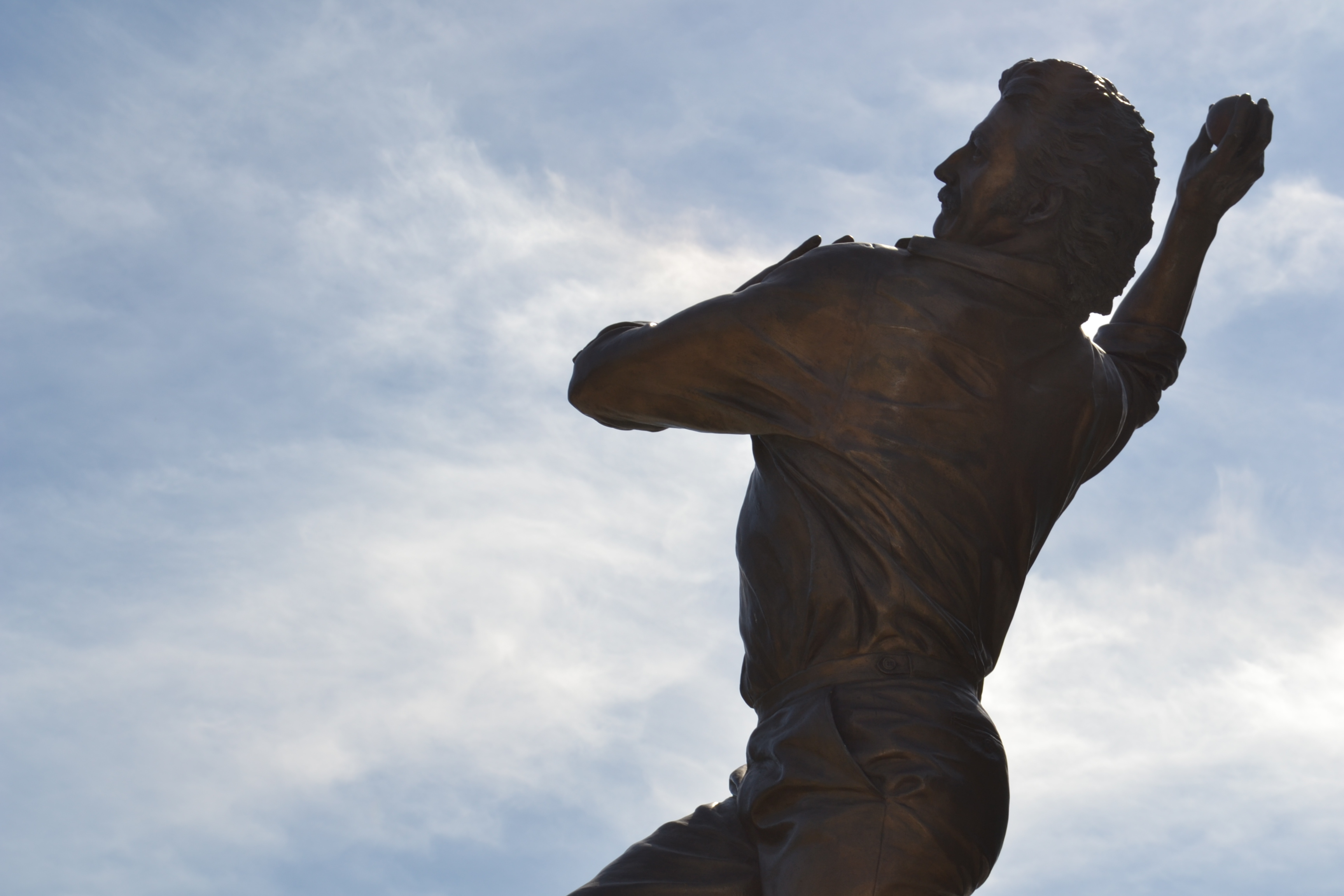UNVEILED: December, 2006
LOCATION: Outside Gate 1
Dennis Lillee was the most accomplished and consistently hostile fast bowler of his time. At his peak no one was faster, more competitive, more menacing or resourceful.
By his career's conclusion Dennis had claimed a world record 355 Test wickets and had become an Australian sporting legend. There is strong support among senior cricket officials, players and the media for the contention that he was the greatest Australian pace bowler of any era.The West Australian dynamo also must be included in the top bracket of the international sporting elite who have triumphed over crippling injury to achieve their highest aspirations. Lillee's return to test cricket after being sidelined for 18 months with a career-threatening back injury was the culmination of a rehabilitation program demanding the utmost in patience and perseverance. Cricket history offers no evidence of a more courageous comeback.
Lillee appeared on the scene when Australian fast bowling was in the doldrums following the retirement of Graham McKenzie. He first played for Western Australia in 1969 and though relatively raw and erratic could generate alarming pace. Within a year he had headed the averages for an Australian B team in New Zealand. Subsequently he was picked for Australia in the sixth test against England at Adelaide in 1971. He made the most of this opportunity by taking 5 for 84, confirming the emergence of a top-quality paceman.
Next season Lillee gave further evidence of his ability with a magnificent 8 for 29 against a strong Rest of the World combination at Perth and on his first tour of England in 1972 set an Ashes series record for an Australian bowler by capturing 31 wickets.
Lillee's test future seemed assured, but against Pakistan at Melbourne in 1973 he hurt his back. Initially the injury responded to treatment and he was selected for the West Indies tour later that year. However, he broke down in the first test with what was later diagnosed as a stress fracture of the lumbar vertebrae. With this second breakdown the cricket public believed that the fast bowler's career probably was at an end.
Lillee, however, was undeterred by the gloomy prognosis and after six weeks with his back encased in plaster he embarked on a recovery program. A former schoolmaster of Dennis's at Belmont High and then exercise physiologist at the University of Western Australia, Dr Frank Pyke, arranged a sequence of back strengthening routines. And the great bowler's running action was adjusted under the guidance of Austin Robertson Senior, an experienced athletic coach who had contested the world professional sprint championship series in Melbourne in the 1930s and was a noted footballer with the famous South Melbourne team of that period.
The physical training programming and supervision of Pyke and Robertson, allied with Lillee's extreme determination, provided a winning recovery formula. Dennis had done plenty of training prior to the injury but according to his wicketkeeping accomplice, Rod Marsh: "He did a heck of a lot more after it."
A critical aspect of this rehabilitation was the need for the bowler to modify his overall method, with the objective of minimising, perhaps eliminating, any possibility of further back strain. "He changed everything," said Marsh, "his running action, approach to the wicket and his delivery. All of this to achieve optimum economy of style."
A revitalised Lillee returned to the test arena only about a yard below his pre-injury pace, but brimful of enthusiasm. And what a return it was! Australia had uncovered another "fire and brimstone" opening bowler in Jeff Thomson and for several years the pair formed the most potent strike force in world cricket. When England toured Australia in 1974-75 the duo captured 58 wickets between them, inspiring parochially patriotic crowds to chant: "Ashes to ashes, dust to dust; if Lillee don't get you, Thommo must!"
In protecting his back, Lillee had adopted a more measured approach in his bowling, exploiting sustained control and great variety. He used the express delivery less frequently than when a young "tearaway", relying mainly on a mixture of leg cutters, pace changes and his near-perfect outswingers.
But he retained the element of surprise with his ability to produce unexpected, awkward bounce. Rod Marsh, who saw more of Lillee at close quarters than anyone else, said the strongest feature of Dennis's bowling was his unrivalled ability to bowl long spells, maintaining his pace and keeping the outswinger going throughout.
Lillee had plenty of highspots to compensate for earlier pain and inconvenience through injury, such as his 5 for 15 in the first test of the 1975 English tour and a fast and furious innings at Lord's in the second test which produced his highest test score of 73 not out. Then there was a mighty and most memorable effort in the MCG Centenary Test of 1977, when he obtained 6 for 26 and 5 for 139 to play a dominant role in Australia's 45-run victory - the exact margin of the Australian win in the first test 100 years earlier. On two occasions during the 1972 test series in England, Lillee took three wickets in four balls.
After two years out of test cricket whilst playing on the World Series Cricket circuit Lillee returned to pass Richie Benaud's 248 wickets and become Australia's test record-holder. He had taken a world record 355 test wickets on his retirement from international cricket. Latterly, this energetic and colourful figure on many test arenas is keenly sought at home and overseas as a fast bowling coach.



